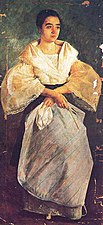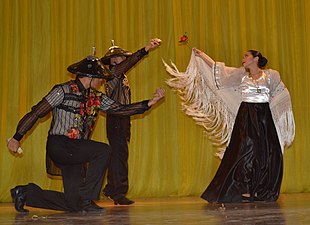Pañuelo
 Early 19th century pañuelo. Metropolitan Museum of Art | |
| Type | Kerchief, shawl |
|---|---|
| Material | Piña fiber |
| Place of origin | Philippines |

The pañuelo or alampay is a Filipino lace-like embroidered neck scarf or shawl worn around the shoulders over the camisa (blouse). They were square-shaped and were folded in half into a triangle when worn. Pañuelos are the direct predecessors of the Manila shawl. The Spanish word pañuelo (from paño + -uelo) means kerchief, scarf, and handkerchief.
Description
Pañuelos were traditionally made from sheer lace-like nipis textiles woven from
They were an integral and distinctive part of the traditional
History
Pañuelos were derived from traditional shawls in the
Pañuelos were copied by
Modern Usage
Since the 1930s pañuelos have been part of the modernized traje de mestiza. In modern days pañuelo can still be seen worn with the modern terno; especially on older women. Pañuelo or alampay has also been an integral part of Iglesia ni Cristo church uniforms worn by deaconesses in all locale congregations in the Philippines. This white terno, called Saya in Filipino, resembles its early deaconess uniforms worn during the 1930s. They can be decorated with embroidery or have simple designs.
Gallery
-
An 1668 illustration by Francisco Ignacio Alcina depicting a Visayan datu and a binukot noblewoman with a veil (alampay) and a salakot
-
Tagalog couple from the Boxer Codex (c. 1590), the woman is wearing an alampay around her shoulders, the precursor to the pañuelo and the Manila shawl
-
FilipinaPaul de la Gironiere
-
traje de mestizawith a pañuelo
-
La Mestisa byJustiniano Asuncion (c. 1841), showing a woman in a striped baro't sayawith a pañuelo
-
Woman in atraje de mestizawith a pañuelo and abanico folding fan (c. 1900)
-
Dancers from thetraje de mestizadress
See also
References
- ^ a b c Sumayao, Marco (24 May 2018). "Can the Baro't Saya Ever Return as an Everyday Filipino Fashion Staple?". Town&Country. Retrieved 19 May 2019.
- ^ a b c Ramos, Marlene Flores (2016). The Filipina Bordadoras and the Emergence of Fine European-style Embroidery Tradition in Colonial Philippines, 19th to early-20th Centuries (Thesis). Mount Saint Vincent University.
- ^ a b "Terno". SEASite. Center for Southeast Asian Studies, Northern Illinois University. Retrieved 16 December 2018.
- ^ Arranz, Adolfo (27 May 2018). "The China Ship". South China Morning Post. Retrieved 19 May 2019.
- ISBN 9780195182040.
- ISBN 9781462906987.
- ISBN 9780292787612.







